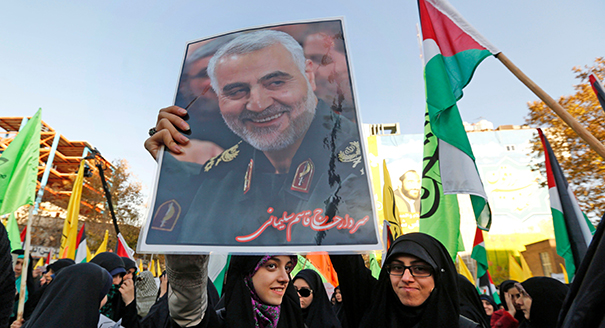Hassan Hassan | Director of Non-State Actors Program at the Center for Global Policy in Washington, D.C., and co-author of ISIS: Inside the Army of Terror (Regan Arts, New York, 2015)
Like it or not, President Donald Trump’s policy against Iran is working as intended. The “Maximum Pressure” campaign is causing the regime to become nervous and lash out. The unprecedented and uncharacteristic attack on Saudi oil facilities last September, attributed to Iran, was symptomatic of its growing anxiety.
With reports that Iran is moving short-range missiles into Iraq to hit U.S. forces, Washington’s response is simply to stay the course, tighten the economic screws, and keep up the pressure against the Islamic Republic. Despite warnings of a U.S.-Iran confrontation due to heightened tension, neither side wants war. But Iran also understands that Trump is determined to destabilize its regime.
Increased pressure will further strain Tehran’s ability to manage erupting crises in countries where only a year ago it saw significant victories—in Syria against the anti-government rebels, in Iraq against the Islamic State, and in Lebanon through a Hezbollah-friendly government. The continued American presence in Syria, the persistence of protests in Lebanon and Iraq, and the worsening sanctions are constraining the regime.
Under these circumstances, Tehran’s current policy seems to be focused on preventing Washington from acting militarily against it and on waiting Trump out. To hold the line until then, Iran is trying to show strength. Moving the missiles and attacking the Saudi oil facilities are part of that effort. There is no need for the United States to lash out. It just needs to press on.
Loulouwa Al Rachid | Beirut-based analyst of Iraq, former scholar at the Carnegie Middle East Center in Beirut
The late French theoretician of international relations, Raymond Aron, once defined the Cold War between the United States and the Soviet Union in this way: “Peace impossible, war unlikely.” This formula applies perfectly to U.S.-Iran relations. Both countries have a great deal to lose by entering into a war or engaging in escalation beyond unclaimed attacks on oil tankers and facilities, Iran’s deployment of short-range missiles outside its borders, an increased U.S. military presence in the Middle East, and cyberwarfare.
For both countries to go on the offensive in Iraq, a fragile country where the crisis over government legitimacy runs the risk of sparking another civil war, would have a devastating impact not only on Iraq but also on the United States’ and Iran’s respective strategic interests in the region. Washington cannot afford a further deterioration in its credibility by allowing the breakup of a country where it imposed costly regime change in 2003, nor can Iran put at risk the political, economic, and military influence it gained there since that time. Their shared condominium over Iraq, which allowed among other things the successful war on terror, will likely prevail, all the more so given the reluctance of Iraqi politicians to be drawn into a proxy war between Washington and Tehran.
Michael Knights | Senior fellow at The Washington Institute, specializing in the military and security affairs of Iraq, Iran, and the Persian Gulf states
The first action—already taken last May by U.S. Secretary of State Mike Pompeo—is to warn Baghdad explicitly that any effective attacks on U.S. forces in Iraq will be met by vigorous self-defense and retaliatory actions inside Iraq as well as elsewhere. This message must be continually reinforced by senior U.S. government officials. As mobile launch platforms may relocate or be collocated with civilians, the United States needs to maintain updated sets of pre-vetted “response option” targets that can be struck at a time and place of its choosing. The United States should wait, if need be, for militia headquarters to re-fill, not just strike empty buildings as quickly as possible. Any target in Iran, Iraq, Lebanon, Syria, Yemen, or elsewhere should be considered fair game.
Joel Wing | Analyst of Iraqi affairs at the Musings on Iraq blog
The latest news that Iran is moving missiles into Iraq is actually old as these types of stories have come out since 2015, when Tehran began giving short range missiles to its allies in the Popular Mobilization Forces (PMF) during the war against the Islamic State. In fact, in July and August 2019 Israel carried out a series of airstrikes against PMF bases in part to target these armaments.
There is little the United States can do about this development. First, its influence has dramatically decreased in Baghdad. The U.S. presence is constantly attacked by Iraqi politicians and resigned prime minister ‘Adil ‘Abdul Mahdi has done nothing about Iran’s moves. Second, despite Washington’s “Maximum Pressure” policy against Iran, President Donald Trump is not really interested in Iran, and especially not Iraq. That means the U.S. government is severely limited in what it can do because it is cannot get the backing of the president. Just look at what’s happening in Syria or Trump’s offer of engaging in talks without preconditions with Iran to see the problems policymakers are having with the president.








